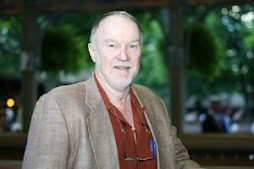Tamariello discusses epistasis and epigenetics, both of which complicate the simple DNA approach. Just because you have a particular gene, it doesn't necessarily drive the phenotype. The control of the expression of genes into proteins that actually govern the body. Just by looking at the gene sequence alone, you can't predict everything.
Tamariello's company screens for:
Two muscle-related genes
Two behavior genes
Two bone development genes and
One energy-related gene
plus Whole genome screening and other higher-level screening.
Tamariello is going over basic genetic biology that everybody in the crowd should already know. Apologetic for perhaps talking down to the audience, but still that's what he's doing. Good refresher course for those too far removed from Biology 101 I suppose.
Once through with the basics, he moves on to more specific stuff related to the Thoroughbred.
Muscle Gene 1, a gene linked to muscle function. Two alleles, racing and non-racing. Thoroughbred breeders have bred over centuries to have 2 copies of the racing allele, but there is a sub-population that is not homozygous. Heterozygous can be successful, but homozygous recessive (non-racing) are too slow to even make it to the track. This is the genotype found in most draft horses. Having 2 copies of the racing alleles, however, does not make it a fast horse.
"Equine genomics will enhance and enable good horsemanship, not compete with it Genomics in no way threatens the importance and artistry of horsemanship."
"What we're tyring to do is localize what region in the genome has an association with the trait you're studying. We know where in the genome where each SNP is located, know the frequency of each allele in the population. Then we compare the frequency of alleles in the population as a whole to the population with the trait you're studying.
When you find differences, that shows theres' something of interest on that particular chromosome at that particular position. Then look back at the genome map and see what genes are in that region.
The horse was added to the USDA Animal Genome Mapping project in 1996. The Human Genome project extended from 1990—2003. That gave all of animal sciences a blueprint for the genome but also provided new technology for the sequencing of other genomes, including the horse.
NIH decided they could learn additional information by sequincing the genomes of other species to compare the human genome to that of other species. The horse community convinced the NIH to select the horse to sequence among equids, because of the community of scientists working on horse genetics, there were already several well-developed genome maps; there are many biomedical aspects of horse that relate to human health, for example at the elite athlete level; veterinary medical applications; and the existence of deep pedigrees to study the inheritance of traits.
The proposal was submited to NHGRI in 2005. Sent samples to the Broad Institute in November 2005. NIH looked for a highly inbred horse, because of the way DNA is sequenced. With a highly inbred individual, the two halves are more similar, so easier for the computer program to put it together. A Thoroughbred mare named Twilight was chosen. Sequencing started in 2006 and completed fall 2007.
"We're anticipating that genetic research will reinforce and validate much of the analysis that we see in Thoroughbred pedigrees."
"Relying solely on pedigree is foolhardy, but likewise so is dismissal of pedigree as unimportant. Pedigree will continue to be an important eliminating criteria.Maybe 5-10 years away we're going to see a change in what pedigree actually means. What we're seeing with genetics is that though a mare might be an Easy Goer mare, she has very little of Easy Goer's good genes. Genetics can tell us what has actually been passed on instead of just a theoretical assumption and we might breed two mares by the same sire entirely differently."
"In terms of pedigree research in my time in the industry we've gone from split pedigree books and doing everything by hand to computer programs that access every horse in the population. Now everybody can have access to the data. What is now important is how to interpret the data."
Of course what came next was basically a sales pitch for Alan's and Byron's True Nicks program, but hey, that's why all the speakers are here. It's a capitalist country!


good note-taking, John. sounds tedious as death.
ReplyDeleteGee Frank, I must not be a very entertaining writer!
ReplyDeleteInterestingly enough....It's not. Sure, there are spates of tedium, but overall, it's been very informative if not exactly entertaining.